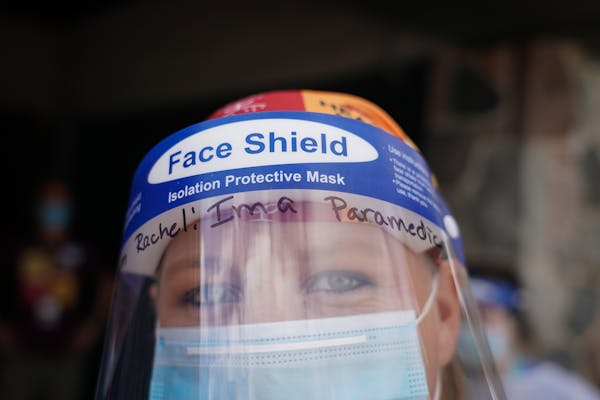Two statistical milestones suggest trouble ahead for Minnesota in the COVID-19 pandemic as health officials warned Monday that the state's new case rate now exceeds the national average and outpaces growth for the first time in the number of diagnostic tests performed.
State Health Commissioner Jan Malcolm said there are signs of COVID-19 growth statewide — and that Minnesota has overlooked the risk of viral transmission in family and friend gatherings compared with supermarkets and stores where mask-wearing and social distancing have become the norm.
"These informal gatherings have proved to be a weak spot in our collective statewide response to the pandemic," said Malcolm, heeding warnings passed along Sunday by White House COVID-19 task force leader Dr. Deborah Birx.
Malcolm's warning on Monday was juxtaposed with the state reporting only one COVID-19 death — the lowest single-day total since mid-April. That brought the state's death toll to 1,817.
The 306 COVID-19 hospitalizations on Monday also reflected a plateauing of severe cases through much of August, but Malcolm said the state needs to act before either of these trends worsens.
Malcolm urged people to rededicate themselves to the basics of mask-wearing, social distancing, staying home when sick and washing hands.
"If we wait to ring the alarm bell until we see hospital levels and mortality increasing," Malcolm said, "we've already lost control of our ability to impact the pandemic. We would have tipped over into exponential growth."
Minnesota now has a new case rate above the national average, according to data Birx provided to Malcolm on Sunday. The state also has reported an increase in the positivity rate of diagnostic tests from 4.9% two weeks ago to 5.2% last week. Case growth has increased 7.9% over the past week and for the first time was larger than the 7.6% increase in testing activity, Malcolm said.
Birx on Sunday said the number of counties with positivity rates above 10% has increased from two to nine. Health officials warned that case growth has been statewide, though.
State infectious disease director Kris Ehresmann said group outbreaks at weddings and barbecues generally result from a lack of compliance with safety measures that often are followed in retail and public places.
"When people are not following those rules, that's when we're seeing the transmission," she said.
Several smaller schools and school districts have had to change reopening plans due to outbreaks involving teachers who were likely infected during planning conferences and social gatherings afterward, Ehresmann said.
The Montevideo School District in west-central Minnesota canceled its scheduled first day on Monday and switched to all online learning for the remainder of the week.
The district had planned to open with a mix of in-person and hybrid classes despite two known COVID-19 cases involving teachers, but then more cases of illnesses emerged this weekend — with some teachers potentially exposing one another to the virus last week during a social gathering.
Twenty-three teachers are quarantined due to exposure risks, though no more positive COVID-19 test results have emerged, said Montevideo Superintendent Luther Heller. "We have had some people that were together at a gathering after conferences earlier this week, but we've also had a group of employees [with illnesses] that weren't at that."
Stevens Community Medical Center in Morris, Minn., is reporting on its Facebook page "strong evidence" of unidentified COVID-19 cases in Stevens County. Some cases are reportedly centered on a church congregation in nearby Hancock.
Executives for the county's public health agency and the hospital did not return calls for comment, but Ehresmann said there have been troubling reports statewide of people who have refused testing to hide illnesses that could disrupt local school or community activities.
Ehresmann discouraged that practice. A parent might want to hide an illness of a young athlete, for example, but that puts the entire team at risk and forces coaches to step in if they notice symptoms.
"You may think that will solve the problem" to avoid testing, she said. "It really doesn't."
Ehresmann also noted that people with moderate risk of exposure to the virus must complete 14-day quarantines even if they receive test results midway suggesting they aren't infected. Infections can emerge after negative test results, she noted.
Minnesota reported 679 newly lab-confirmed infections on Monday, bringing its total in the pandemic to 75,864. That includes 67,656 people who recovered to the point that they are no longer considered infection risks or required to isolate themselves.
Minnesota and Wisconsin continue to rate as "trending poorly" on the COVID Exit Strategy website due to the rate of growth in infections, while Iowa and the Dakotas have a worse rating of "uncontrolled spread." Average daily case numbers have more than doubled over the past two weeks in all three border states.
The Minnesota Department of Health on Monday reported an updated total of 49 people with positive infections who participated in the Sturgis Motorcycle Rally in South Dakota. Two of those people are hospitalized.
An uptick in cases in Winona County appears to be linked to the return of students to local colleges, Ehresmann said. Statewide, there have been more than 250 known infections involving college students and staff members — many of whom were infected elsewhere and brought the virus to campuses.
The state has advised college students to avoid group gatherings in the two weeks before returning to campuses to increase their chances of arriving virus-free.
Jeremy Olson • 612-673-7744
Body camera video shows Minnetonka man repeatedly shooting at deputies before dying in firefight
Oakdale issues warning after coyote attacks dog in nature preserve

Anoka County extends search for county administrator

Minneapolis schools, teachers reach tentative agreement to avert strike

